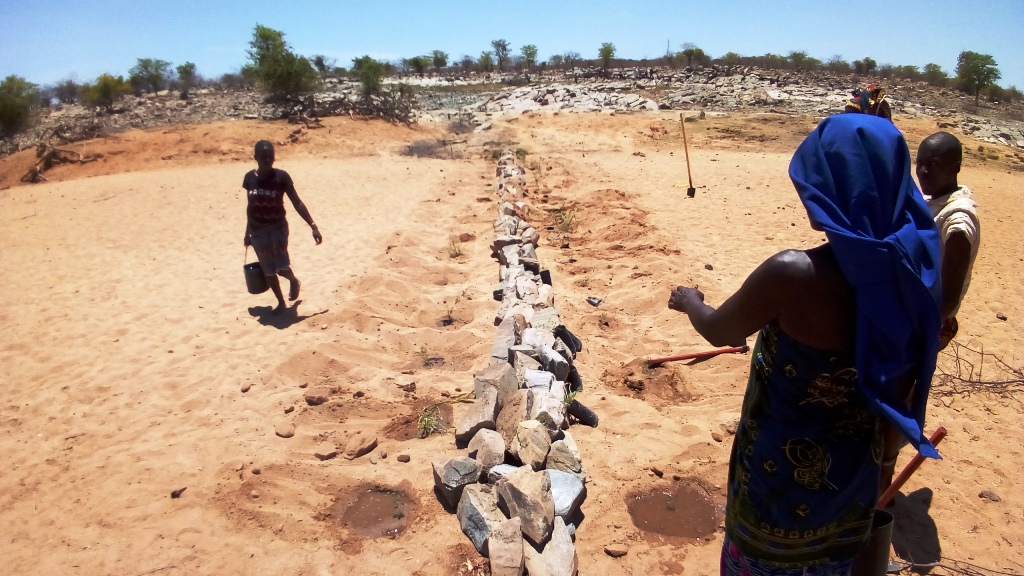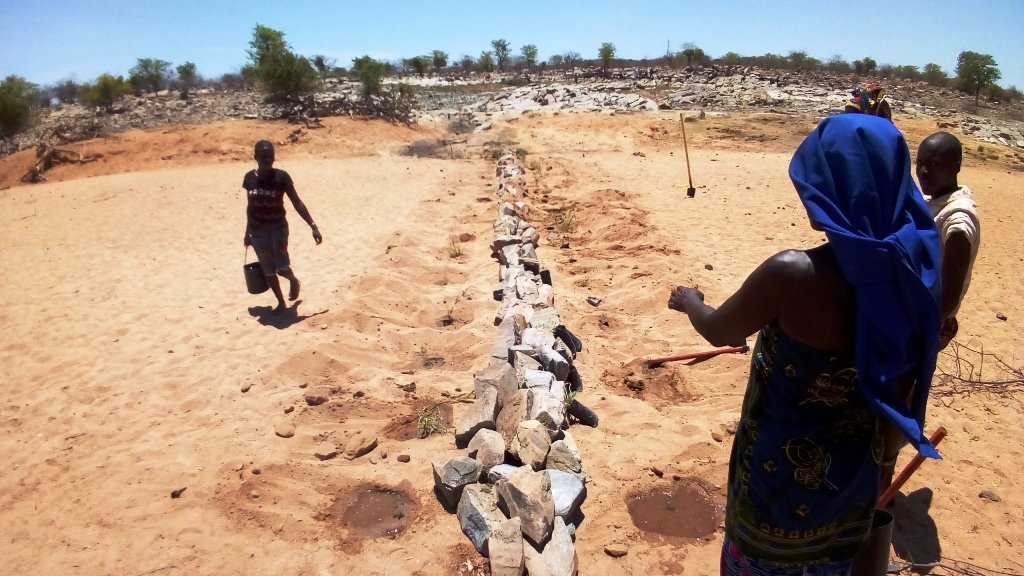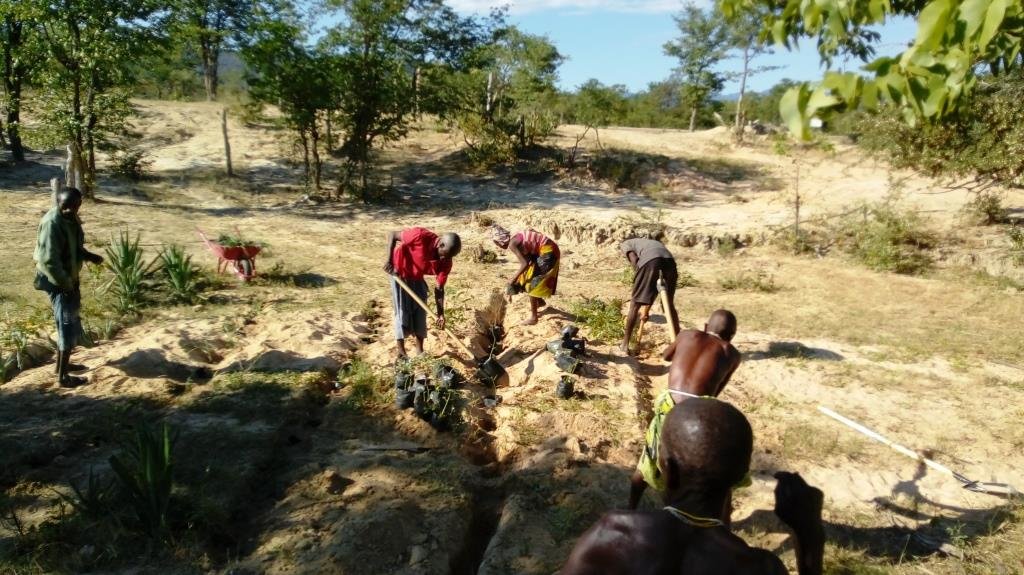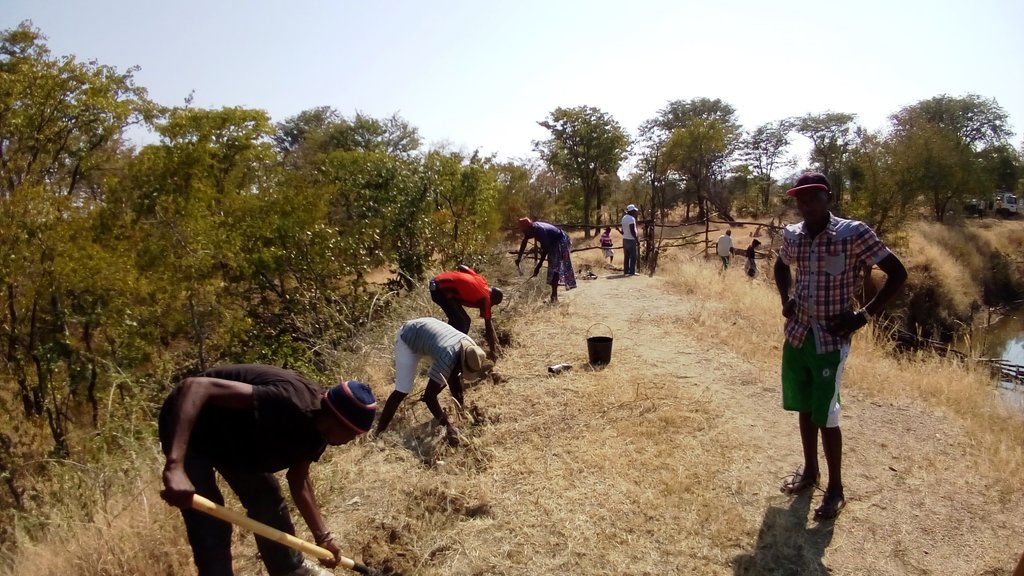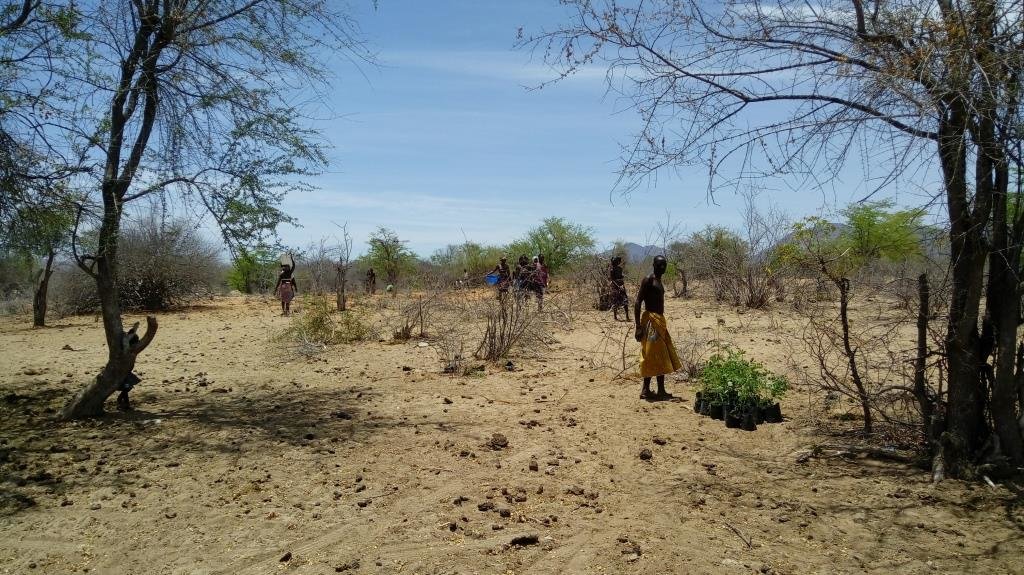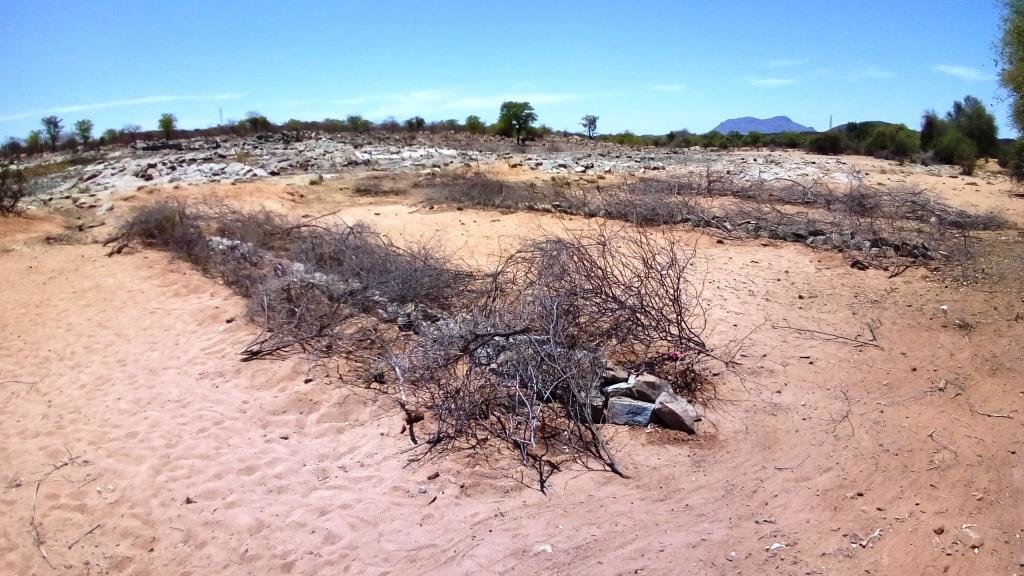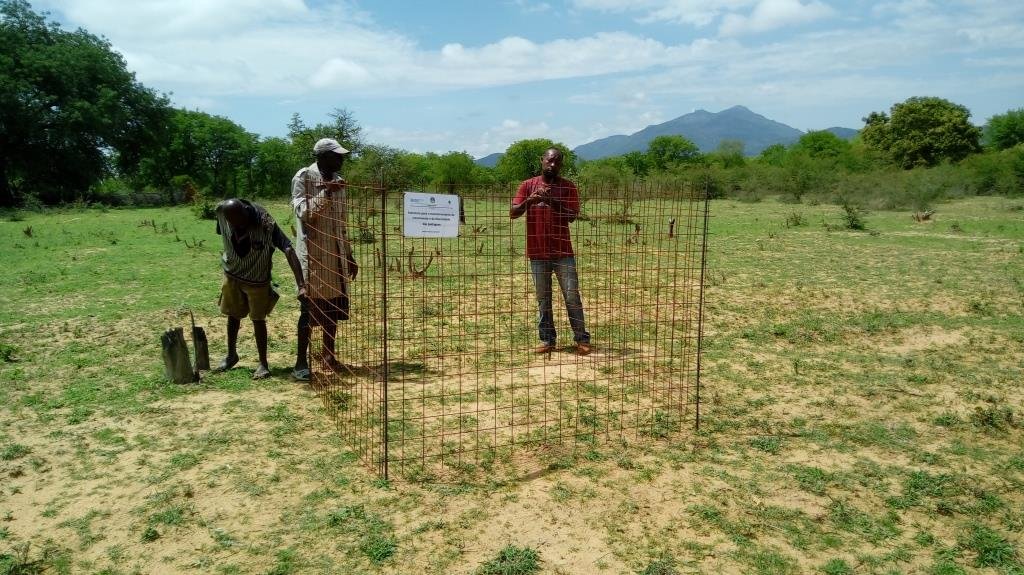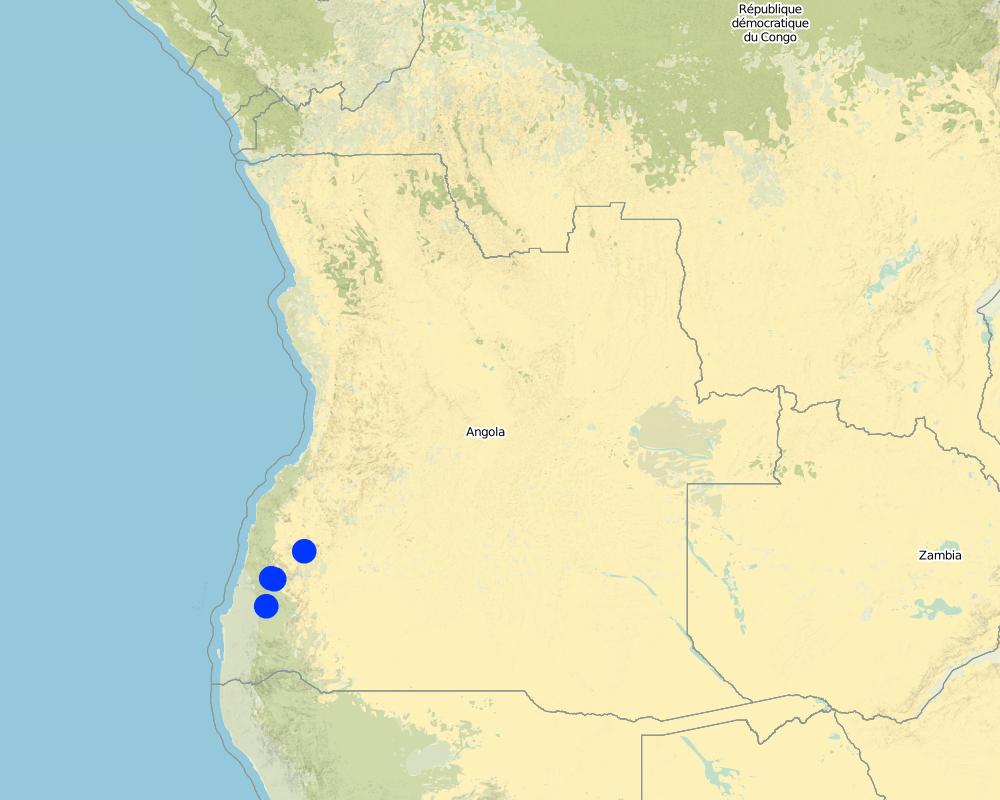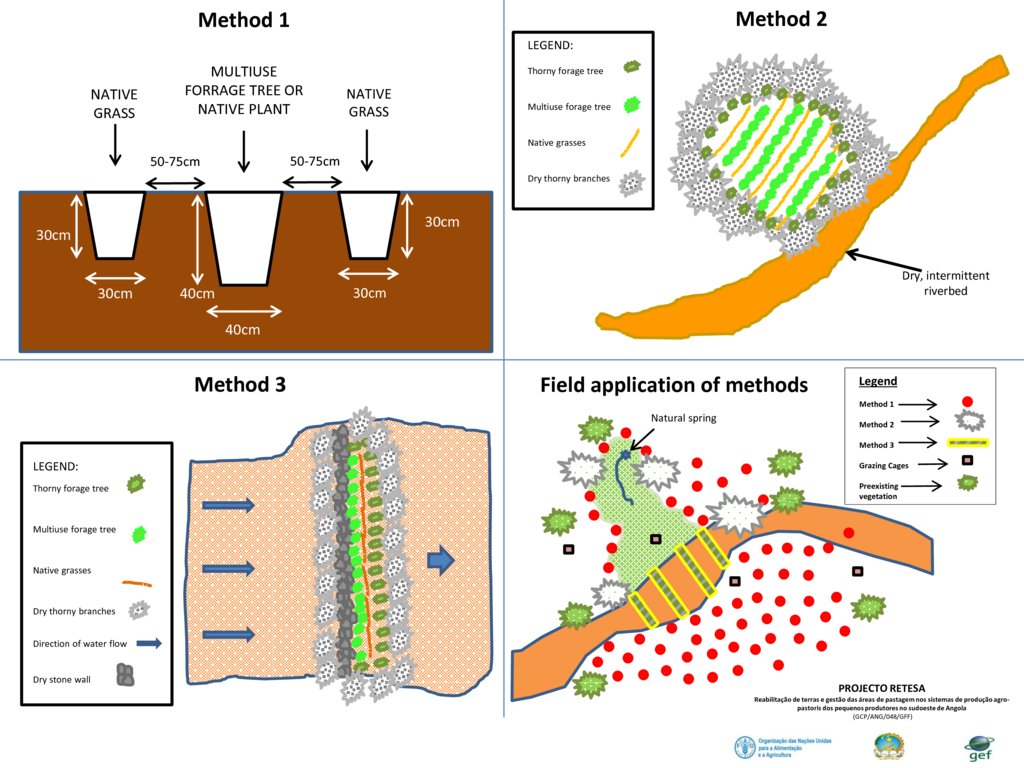Community supported pasture and rangeland rehabilitation works [安哥拉]
- 创建:
- 更新:
- 编制者: Nicholas Euan Sharpe
- 编辑者: Txaran Basterrechea
- 审查者: Rima Mekdaschi Studer
technologies_3141 - 安哥拉
- Community supported pasture and rangeland rehabilitation works: Jan. 31, 2018 (inactive)
- Community supported pasture and rangeland rehabilitation works: Feb. 16, 2018 (inactive)
- Community supported pasture and rangeland rehabilitation works: March 6, 2019 (inactive)
- Community supported pasture and rangeland rehabilitation works: Nov. 2, 2021 (public)
查看章节
全部展开 全部收起1. 一般信息
1.2 参与该技术评估和文件编制的资源人员和机构的联系方式
SLM专业人员:
有助于对技术进行记录/评估的项目名称(如相关)
Reabilitação de terras e gestão das áreas de pastagem nos sistemas de produção agro-pastoris dos pequenos produtores no sudoeste de Angola (RETESA)有助于对技术进行记录/评估的机构名称(如相关)
FAO Angola (FAO Angola) - 安哥拉1.3 关于使用通过WOCAT记录的数据的条件
(现场)数据是什么时候汇编的?:
15/05/2017
编制者和关键资源人员接受有关使用通过WOCAT记录数据的条件。:
是
1.4 所述技术的可持续性声明
这里所描述的技术在土地退化方面是否存在问题,导致无法被认为是一种可持续的土地管理技术?:
否
2. SLM技术的说明
2.1 技术简介
技术定义:
Rehabilitation of rangelands involves selection of key pasture and fodder species, and their reintroduction into strategic areas through stakeholder participation. The technology is also supported by communal management plans, which were created to address the root causes of land degradation.
2.2 技术的详细说明
说明:
This technology was developed and implemented through the RETESA Project “Land rehabilitation and rangelands management in smallholder agropastoral production systems in south-western Angola”. RETESA is a project owned and implemented by the Ministry of Environment of the Government of Angola, with technical and methodological assistance from The Food and Agriculture Organization of the United Nations (FAO), and financed by the Global Environment Facility (GEF).
Inappropriate grazing regimes and poor livestock management by pastoral communities in SW Angola have led to degradation of rangeland and pastoral resources, with perennial grassland species and shrubs having been effectively eliminated. This is despite the fact that the pastoral communities of the area know their environment extremely well and are aware of the land degradation happening around them. Under the project they identified crucial areas for rehabilitation works, selecting mostly areas around water points that have been in use both by local and transhumant herders. Through these works, the local community sought to (a) increase ground cover to reduce sediment loads entering waterways (erosion control), (b) provide shade for livestock, (c) increase forage production and (d) introduce legumes and multipurpose forage trees in areas of high animal traffic. A total of four areas in the Bibala and Virei Municipalities were identified for the activities.
The communities were closely involved in the selection and propagation of plant species for the rehabilitation works. The project field staff also ran field palatability trials with them to confirm that the plants selected met their expectations. These participatory trials were also aimed at enhancing their understanding of livestock nutrition and how it related to animal health. Once the species were chosen, seed was collected by the communities and the Project Technicians, and was multiplied in 32 Agro-Pastoral Field School Nurseries and 2 Government funded Veterinary Research Stations. A total of 15 species were identified, with the grasses Eragrostis superba, Urochloa mosambicensis, and the trees Acacia nilotica, Faidherbia albida, Leucaena leucocephala and Moringa oleifera being the most valued by the communities as forage and multipurpose species. The trees were germinated from seed with success. However, native grass species failed to germinate by standard methods - early field trials having ruled out direct seeding methods. Thus they were multiplied by root division of plants collected from cultivated fields. This avoided removal of grass from natural areas.
As the majority of the areas selected for the rehabilitation works were focused around water points and waterways, the soils were generally alluvial, sandy loams. Precipitation is highest in the areas to the north: it ranges from 600 mm in the upper areas of the Bibala Municipality to 200 mm in the areas to the south in Virei. In general, the vegetation communities could be described as dry sclerophyll woodlands with Colophospermum mopane being the dominant tree species, with forest cover decreasing in height and density as one moves south toward drier areas.
Through close collaboration with the participant communities, three rehabilitation methods were designed and improved upon throughout the Project's duration. Method 1 was used to plant open areas within the rehabilitation zone, Method 2 was employed to introduce and protect concentrated plantings of the selected species in strategic locations within the landscape, and Method 3 was preferred for the recuperation of riparian vegetation and to reduce sediment loads in waterways. The three methods used are described in more detail in the Technical Drawings. To increase the sense of ownership and thus the sustained effectiveness of the rehabilitation works, land management plans and other supporting activities were also carried out.
2.3 技术照片
2.5 已应用该技术的、本评估所涵盖的国家/地区/地点
国家:
安哥拉
区域/州/省:
Province of Namibe
有关地点的进一步说明:
Municipalities of Bibala and Virei
注释:
There are 3 main rehabilitation areas, all within the Namibe Province in Southern Angola.
Map
×2.6 实施日期
如果不知道确切的年份,请说明大概的日期:
- 不到10年前(最近)
2.7 技术介绍
详细说明该技术是如何引入的:
- 通过项目/外部干预
注释(项目类型等):
The proposed project: “Land rehabilitation and rangelands management in smallholders’ agropastoral production systems in southwestern Angola” (RETESA) is a joint effort by the Ministério do Ambiente (MA), Ministério da Agricultura e do Desenvolvimento Rural e das Pescas (MINANDER), Governo Provincial do Namibe, Governo Provincial do Huila, and Governo Provincial de Benguela, together with FAO and GEF. In line with the GEF-5 Land Degradation strategy, the project’s goal is to create an enhanced enabling environment in the agricultural sector and a sustained flow of agro-ecosystem services.
3. SLM技术的分类
3.1 该技术的主要目的
- 改良生产
- 减少、预防、恢复土地退化
- 保护生态系统
- 保持/提高生物多样性
- 降低灾害风险
- 适应气候变化/极端天气及其影响
- 减缓气候变化及其影响
- 创造有益的经济影响
3.2 应用该技术的当前土地利用类型

牧场
粗放式放牧场:
- 半游牧/游牧
- Transhumance movements
主要动物种类及产品:
Cattle and goats.
Milk and meat.

水道、水体、湿地
- 排水管道、水道
- 池塘、大坝
- Natural springs
如果由于技术的实施而导致土地用途发生变化,则在技术实施前说明土地利的用途。:
Crop land is increasing in the area as population increases and people move towards more sedimentary livelihoods.
3.3 有关土地利用的更多信息
该技术所应用土地的供水:
- 雨养
每年的生长季节数:
- 1
牲畜密度(如相关):
Official data is not available and true livestock numbers are unknown.
3.4 该技术所属的SLM组
- 畜牧业和牧场管理
- 改良的地面/植被覆盖
3.5 技术传播
具体说明该技术的分布:
- 适用于特定场所/集中在较小区域
注释:
Planting areas are selected due to their importance and relevance to the local communities. For the most part, the plantings have been centred around key water points. In order to increase impact and scale up the process of rangeland rehabilitation and improvement, management plans are negotiated and agreed upon by the communities through the Green Negotiated Territorial Development Approach (GreeNTD) processes.
3.6 包含该技术的可持续土地管理措施

植物措施
- V1:乔木和灌木覆盖层
- V2:草和多年生草本植物

管理措施
- M2:改变管理/强度级别
注释:
The management plans created at the community and administrative level identify a number of large areas which are to serve as 'Grazing Reverses' for the dry season. Therefore, the agreements call for all livestock to abandon the area at the onset of the first rains and not return until the Pastoral Management Forum agrees to open the area for grazing. Once open, the range is available to all pastoralists, those that live in the immediate area and those moving through on their transhumance migration.
3.7 该技术强调的主要土地退化类型

土壤水蚀
- Wt:表土流失/地表侵蚀
- Wr:河岸侵蚀

生物性退化
- Bc:植被覆盖的减少
- Bh:栖息地丧失
- Bq:数量/生物量减少
- Bs:质量和物种组成/多样性的下降
- Bl:土壤寿命损失
3.8 防止、减少或恢复土地退化
具体数量名该技术与土地退化有关的目标:
- 减少土地退化
- 修复/恢复严重退化的土地
4. 技术规范、实施活动、投入和成本
4.1 该技术的技术图纸
4.2 技术规范/技术图纸说明
Planting is typically based on three different methods, as seen in the figure above.
- Method 1 relies on placing a leguminous, multipurpose tree species in the ground with two native grass species to each side of the tree. The holes are dug and a small amount of manure is placed in the bottom of the hole, adding some water if it is readily available. Then the trees and grasses are planted and well-watered. Finally, a branch or two of thorny shrubs or trees are placed over the plants to protect them from being grazed (where possible, dead branches should be used, rather than cutting living plants).
- Method 2 requires the creation of an enclosed, protected area which is then planted at high densities, preferably in low-lying areas where adequate soil moisture is available. Dry, dead branches from thorny trees and shrubs are used to create the enclosures and provide protection to these plantings.
- Method 3 is based on the creation of a 'leaky weir', which is a small stone barrier, horizontal to the flow of water (on the contour) planted with a mixture of native riparian species. This is intended to slow the flow of water and stimulate the recovery of riparian vegetation. The plants are also protected with dry, dead branches from thorny trees and shrubs in this method.
To increase their effectiveness, it is recommended that the three methods be combined within the landscape, as seen in the 4th slide 'Field application of methods'.
4.3 有关投入和成本计算的一般信息
具体说明成本和投入是如何计算的:
- 每个技术单元
指定单位:
3345 seedlings produced, delivered and planted
指定体积、长度等(如果相关):
3345 units
具体说明成本计算所用货币:
- 美元
注明雇用劳工的每日平均工资成本:
6 Dollars
4.4 技术建立活动
| 活动 | 措施类型 | 时间 | |
|---|---|---|---|
| 1. | Meetings and field visits with participant communities to identify plant species and their uses | 其它措施 | Best during growing season |
| 2. | Further meetings to decide on which species are to be multiplied and arrange seed collection | 其它措施 | Near end of growing season |
| 3. | Seed collection and transportation | 其它措施 | When seed is available (varies with species) |
| 4. | Instalation of irrigation systems | 结构性的 | Most communiites need a water extraction and distribution system to create nurseries |
| 5. | Delivery of nursery supplies and instalation of shade cloth | 结构性的 | Nurseries should have water access and shade |
| 6. | Planting of seeds and care for seedlings at nursery | 植物性的 | Formed part of Agro-Pastoral Farmer Field School activities |
| 7. | Identification of planting areas and timing | 其它措施 | Should be at beginning of rainy season, or when soil moisture permits |
| 8. | Organisation of materials and tools | 其它措施 | At least 1 week before the planting |
| 9. | Planting day (preparation of planting holes and transplanting of seedlings) | 植物性的 | 2 days maximum was seen to be optimal |
| 10. | Watering until the plants are established | 农业学的 | Usually a maximum of 3 watering over 1 week after the plantings |
| 11. | Follow up visits to make sure management agreements are being respected and plants are not being eaten by stock until they are ready | 管理 | Plants should not be grazed for at least 6 months from planting time until they are well established |
注释:
The activities and costs given were those needed to produce and plant 3,345 trees and grasses in the 4 rehabilitation areas. Given that 3,345 plants were produced at a cost of $3284.75, the cost per plant produced and planted in the field is $0.98. Seedlings available through local, government nurseries were $2.00 per unit, but only exotic ornamentals were available. However, it can be expected that in other contexts and locations, it would be cheaper to buy seedlings, instead of training communities and creating numerous small-scale nurseries, though clearly these communities will not ‘own’ the process as well as if they were involved from the beginning.
4.5 技术建立所需要的费用和投入
| 对投入进行具体说明 | 单位 | 数量 | 单位成本 | 每项投入的总成本 | 土地使用者承担的成本% | |
|---|---|---|---|---|---|---|
| 劳动力 | Project Technicians/Drivers/Consultants, etc | Person-days | 30.0 | 20.0 | 600.0 | |
| 劳动力 | Plant identification activities and seed collection | Person-days | 10.0 | 6.0 | 60.0 | 100.0 |
| 劳动力 | Plant nursery creation and plant production | Person-days | 16.0 | 6.0 | 96.0 | 100.0 |
| 劳动力 | Participation during planting days | Person-days | 25.0 | 10.0 | 250.0 | 90.0 |
| 设备 | Vehicle | Trips | 10.0 | 40.0 | 400.0 | |
| 设备 | Nursery supplies (including water system which also supplies water to Farmer Field School) | Materials | 1.0 | 800.0 | 800.0 | 10.0 |
| 设备 | Planting supplies (shovels, hoes, wheelbarrows, etc.) | Materials | 1.0 | 120.0 | 120.0 | |
| 设备 | Other improvements to water point (fencing, cement blocks, cement, hoses, etc.) | Materials | 1.0 | 250.0 | 250.0 | |
| 设备 | Maps (traced onto paper from projected images for management purposes) | Materials | 1.0 | 10.0 | 10.0 | |
| 设备 | Food and Refreshments | Per person | 25.0 | 2.5 | 62.5 | |
| 肥料和杀菌剂 | Manure (50 grams per sack, 12.500 sacks) | Kilos | 625.0 | 0.25 | 156.25 | 100.0 |
| 施工材料 | Shade-cloth | m2 | 320.0 | 1.5 | 480.0 | |
| 技术建立所需总成本 | 3284.75 | |||||
如果土地使用者负担的费用少于100%,请注明由谁负担其余费用:
Remaining costs were provided by the RETESA Project.
注释:
Production depends on the ability of the pastoral communities to produce viable plants. If they are unable to do so, then plants can be bought from Government funded nurseries, though costs per plant will most rise though it can substitute the need for having to purchase a water supply system. The total shown here reflects a percentage (16%) of the costs of installing a water system that supplied water to the whole of the Agro-Pastoral Farmer Field School. These systems usually included a 10,000 litre water tank, a gasoline water pump, extraction pipe and parts, 100 to 200 mts of 1.5" hoses and parts and 3 kms of drip irrigation hose.
4.6 维护/经常性活动
| 活动 | 措施类型 | 时间/频率 | |
|---|---|---|---|
| 1. | Meetings to ensure management agreements are being respected. | 管理 | Once every 3 to 6 months, especially before and after rainy season. |
| 2. | Repairs and replacement of nursery supplies. | 结构性的 | Once a year. |
| 3. | Replanting of dead seedlings | 植物性的 | Just before and during rainy season. |
4.7 维护/经常性活动所需要的费用和投入(每年)
| 对投入进行具体说明 | 单位 | 数量 | 单位成本 | 每项投入的总成本 | 土地使用者承担的成本% | |
|---|---|---|---|---|---|---|
| 劳动力 | Visits to sites and tour of planting areas. | Person-days | 4.0 | 20.0 | 80.0 | 50.0 |
| 劳动力 | Driver. | Person-days | 1.0 | 20.0 | 20.0 | |
| 劳动力 | Replanting of dead seedlings | Person-days | 2.0 | 6.0 | 12.0 | 100.0 |
| 劳动力 | Watering | Person-days | 14.0 | 6.0 | 84.0 | 100.0 |
| 设备 | Vehicle | Trips | 1.0 | 40.0 | 40.0 | |
| 设备 | Watering cans and buckets | Materials | 4.0 | 5.0 | 20.0 | |
| 技术维护所需总成本 | 256.0 | |||||
如果土地使用者负担的费用少于100%,请注明由谁负担其余费用:
The RETESA Project provided an important part of both material and technical support to the communities, though the communities also contributed substantially.
4.8 影响成本的最重要因素
描述影响成本的最决定性因素:
The activities and costs given were those needed to produce and plant 3,345 trees and grasses in the 4 rehabilitation areas. Given that 3.345 plants were produced at a cost of $3284.75, the cost per plant produced and planted in the field is $0.98. Seedlings avaliable through local, government nurseries were $2.00 per unit, but only exotic ornamentals were avaliable. However, it can be expected that in other contexts and locations, it would be cheaper to buy seedlings instead of training communities and creating numerous small scale nurseries, though clearly these communities will not appropriate the process as well as if they were involved from the beginning.
5. 自然和人文环境
5.1 气候
年降雨量
- < 250毫米
- 251-500毫米
- 501-750毫米
- 751-1,000毫米
- 1,001-1,500毫米
- 1,501-2,000毫米
- 2,001-3,000毫米
- 3,001-4,000毫米
- > 4,000毫米
有关降雨的规范/注释:
In the past, the rainy season started in October or November and ran until May. However, the rains in the last few years have fallen in January to April.
注明所考虑的参考气象站名称:
None in the area.
农业气候带
- 半干旱
5.2 地形
平均坡度:
- 水平(0-2%)
- 缓降(3-5%)
- 平缓(6-10%)
- 滚坡(11-15%)
- 崎岖(16-30%)
- 陡峭(31-60%)
- 非常陡峭(>60%)
地形:
- 高原/平原
- 山脊
- 山坡
- 山地斜坡
- 麓坡
- 谷底
垂直分布带:
- 0-100 m a.s.l.
- 101-500 m a.s.l.
- 501-1,000 m a.s.l.
- 1,001-1,500 m a.s.l.
- 1,501-2,000 m a.s.l.
- 2,001-2,500 m a.s.l.
- 2,501-3,000 m a.s.l.
- 3,001-4,000 m a.s.l.
- > 4,000 m a.s.l.
说明该技术是否专门应用于:
- 不相关
关于地形的注释和进一步规范:
Usually the planting are undertaken along river plains and river banks, as they are the only areas that have the necessary soil moisture to ensure survival of the seedlings.
5.3 土壤
平均土层深度:
- 非常浅(0-20厘米)
- 浅(21-50厘米)
- 中等深度(51-80厘米)
- 深(81-120厘米)
- 非常深(> 120厘米)
土壤质地(表土):
- 粗粒/轻(砂质)
土壤质地(地表以下> 20厘米):
- 粗粒/轻(砂质)
表土有机质:
- 低(<1%)
5.4 水资源可用性和质量
地下水位表:
< 5米
地表水的可用性:
匮乏/没有
水质(未处理):
不良饮用水(需要处理)
水的盐度有问题吗?:
是
具体说明:
Many bores and wells cannot be used due to Salinity problems. Before planting, it is wise to make sure soil salinity is not problematic in areas identified.
该区域正在发生洪水吗?:
是
规律性:
偶然
关于水质和水量的注释和进一步规范:
Water quality and quantity are major issues for the area. There are few if any reliable water sources in the area and most communities depend on wells dug in the river bottoms to supply their water.
5.5 生物多样性
物种多样性:
- 中等
栖息地多样性:
- 低
关于生物多样性的注释和进一步规范:
The area is devoid of most wild animals due to the years of war the country experienced during the second half of the 20th century.
5.6 应用该技术的土地使用者的特征
定栖或游牧:
- 半游牧的
生产系统的市场定位:
- 生计(自给)
非农收入:
- 收入的10-50%
相对财富水平:
- 非常贫瘠
个人或集体:
- 个人/家庭
机械化水平:
- 手工作业
性别:
- 女人
- 男人
土地使用者的年龄:
- 青年人
- 中年人
说明土地使用者的其他有关特征:
The communities are still traditional though are currently being influenced by the globalisation process.
5.7 应用该技术的土地使用者拥有或租用的平均土地面积
- < 0.5 公顷
- 0.5-1 公顷
- 1-2 公顷
- 2-5公顷
- 5-15公顷
- 15-50公顷
- 50-100公顷
- 100-500公顷
- 500-1,000公顷
- 1,000-10,000公顷
- > 10,000公顷
这被认为是小规模、中规模还是大规模的(参照当地实际情况)?:
- 大规模的
注释:
Agricultural plots are considered private and are usually between 1 to 2 hectares, though grazing land, which makes up the majority of the area, is still commonly owned and covers vast areas.
5.8 土地所有权、土地使用权和水使用权
土地所有权:
- 社区/村庄
土地使用权:
- 自由进入(无组织)
用水权:
- 自由进入(无组织)
5.9 进入服务和基础设施的通道
健康:
- 贫瘠
- 适度的
- 好
教育:
- 贫瘠
- 适度的
- 好
技术援助:
- 贫瘠
- 适度的
- 好
就业(例如非农):
- 贫瘠
- 适度的
- 好
市场:
- 贫瘠
- 适度的
- 好
能源:
- 贫瘠
- 适度的
- 好
道路和交通:
- 贫瘠
- 适度的
- 好
饮用水和卫生设施:
- 贫瘠
- 适度的
- 好
金融服务:
- 贫瘠
- 适度的
- 好
6. 影响和结论性说明
6.1 该技术的现场影响
社会经济效应
生产
饲料生产
SLM之前的数量:
Low rangeland production
SLM之后的数量:
Slight improvement
注释/具体说明:
Difficult to measure. Rehabilitation works and the management plans for the rangeland areas have led to some improvement, though the droughts affecting the area during the interventions significantly affected rangeland fodder production.
饲料质量
SLM之前的数量:
No crop residues or fodder plantings used
SLM之后的数量:
Crop residues and fodder plantings incorporated in cropping areas
注释/具体说明:
The process allowed Project Technicians to educate communities on the use of crop residues as fodder and the planting of multiuse trees within cropping areas to provide green fodder in the dry season. The reintroduction of drought tolerant, quality indigenous grasses should also lead an increase in fodder production over the coming year.
畜牧生产
SLM之前的数量:
No planning for dry season grazing, apart from transhumance movements
SLM之后的数量:
Crop residues and other cultivated forages produced for those animals that stay
注释/具体说明:
The transhumance movements of livestock are still seen as the most adequate solution to changes in natural rangeland production, though most families leave behind some animals with the main family unit. These animals are now receiving the quality feed they need to remain productive and healthy.
土地管理
SLM之前的数量:
No management plans in place for commonly managed natural resources
SLM之后的数量:
Participatory land management plans have been negociated and agreed
注释/具体说明:
Simplified land management plans based on traditional livestock movements and cropping seasons have been negotiated and agreed by local stakeholders and municipal Administrators.
水资源可用性和质量
饮用水的质量
SLM之前的数量:
Livestock and communities drink from same water
SLM之后的数量:
Separate water drinking points for livestock and community
注释/具体说明:
Unrestricted access of livestock to community domestic water points led to waterborne diseases and poor water quality. Separating livestock and domestic use has improved community health.
家畜用水的可用性
注释/具体说明:
In addition to restricting livestock access to main water bodies, new drinking troughs have been built with community support.
家畜用水的质量
注释/具体说明:
By separating livestock drinking points and domestic water points, waterborne illnesses have been reduced. In at least one area a water tank and new drinking trough have been built with community support.
社会文化影响
SLM/土地退化知识
SLM之前的数量:
No education or training on land degradation
SLM之后的数量:
Education and training on land degradation issues and rehabilitation methods
注释/具体说明:
The majority of communities that have gone through the process now understand how poor land management leads to land degradation and steps they can take to reduce it.
生态影响
水循环/径流
水量
注释/具体说明:
Improved ground cover and the return of riparian vegetation would increase infiltration rates and decrease evapotranspiration rates and restore the micro water cycle. But this is also a long term process.
水质
SLM之前的数量:
Low
SLM之后的数量:
Low in short term, improved in long term
注释/具体说明:
Revegetation of river plains and river banks should lead to improved water quality though it will be a long term effect if the rehabilitation areas are respected.
地表径流
SLM之前的数量:
No method to deal with the high surface runoff rates in the area
SLM之后的数量:
A method has been devised for reducing surface runoff rates.
注释/具体说明:
The 'leaky weir' method (Rehabilitation method 3) has shown promise over the duration of the Project and could be applied at other landscape levels to reduce surface runoff.
土壤
土壤覆盖层
注释/具体说明:
The reintroduction of native grasses in the area should lead to improved ground cover, binding the soil and reducing erosion rates.
土壤流失
注释/具体说明:
The reintroduction of native grasses in the area should lead to improved ground cover ratios, binding the soil and reducing erosion rates.
养分循环/补给
注释/具体说明:
Proper livestock management also ensures that manure is properly and evenly distributed in the field.
生物多样性:植被、动物
植被覆盖
SLM之前的数量:
Reduced number of poor quality grass species
SLM之后的数量:
Communities capacitated in plant multiplication methods
注释/具体说明:
Apart from the rehabilitation works themselves, the local communities have been capacitated with methods to approach and deal with land degradation.
生物量/地上C
植物多样性
注释/具体说明:
The reintroduction of native and leguminous plants has improved plant diversity both within rehabilitation areas and cultivated lands.
减少气候和灾害风险
干旱影响
微气候
注释/具体说明:
The works around the water points over time should lead to increase in vegetative cover, shade, habitat and reduced temperatures.
6.2 该技术的场外影响已经显现
缓冲/过滤能力
6.3 技术对渐变气候以及与气候相关的极端情况/灾害的暴露和敏感性(土地使用者认为的极端情况/灾害)
渐变气候
渐变气候
| 季节 | 气候变化/极端天气的类型 | 该技术是如何应对的? | |
|---|---|---|---|
| 年降雨量 | 减少 | 好 | |
| 季雨量 | 春季 | 减少 | 好 |
6.4 成本效益分析
技术收益与技术建立成本相比如何(从土地使用者的角度看)?
短期回报:
中性/平衡
长期回报:
积极
技术收益与技术维护成本/经常性成本相比如何(从土地使用者的角度看)?
短期回报:
中性/平衡
长期回报:
积极
6.5 技术采用
- 单例/实验
在所有采用这项技术的人当中,有多少人是自发地采用该技术,即未获得任何物质奖励/付款?:
- 0-10%
6.6 适应
最近是否对该技术进行了修改以适应不断变化的条件?:
否
6.7 该技术的优点/长处/机会
| 土地使用者眼中的长处/优势/机会 |
|---|
| Communities learn about plants' role in the wider ecosystem, how to select and multiply key fruit, fodder or timber species and should see an increase in their horticultural and livestock production, leading to improved nutrition or income. |
| Done properly, it can be a cost-effective and reliable way to produce the plants needed within family units. |
| 编制者或其他关键资源人员认为的长处/优势/机会 |
|---|
| When the plants are produced in collaboration with the local pastoral communities, the benefits are wide ranging, promoting everything from environmental awareness to technical and practical knowledge. |
| It remains a cost-effective way of improving key productive species and increasing community resilience. |
| Increasing biomass and introducing better management cycles contribute to reducing land degradation and improve nutrient and energy cycling. |
6.8 技术的弱点/缺点/风险及其克服方法
| 土地使用者认为的弱点/缺点/风险 | 如何克服它们? |
|---|---|
| Can require stable supply of water, and labour costs can increase if water sources are not easily accessible. | Locate nurseries near reliable and accessible water sources. |
| Can require permanent residence, so as to be able to care for plants until they are developed and placed in the ground at the proper date in the calendar (before or during rainy season). | Not easy in nomadic cultures. |
| Early attempts often fail to produce lasting results. | Concentrate early efforts on small experimental plots so as to fine-tune planting methods and timing. |
| 编制者或其他关键资源人员认为的弱点/缺点/风险 | 如何克服它们? |
|---|---|
| The technology is usually not suitable for large areas of land (>1,000 hectares). | Compliment any rehabilitation efforts with improved management plans which are developed with stakeholder input and approval. |
| Plant losses are typically high, especially if rains fail to arrive, or if the year is abnormally dry. | Watch weather forecast to try and focus planting campaigns on those days with a high probability of rain. |
| Local species are often not valued by local officials and technicians, leading to a predominance of exotic species in rehabilitation works. | Undertake awareness and training sessions which highlight the value and uses of native species with local land users and administrative officials. |
7. 参考和链接
7.1 信息的方法/来源
- 实地考察、实地调查
The Project has a number of activities in the communities where the technology was used so there were numerous visits and interviews.
- 与土地使用者的访谈
Various information and survey methods were used throughout the RETESA Project, providing a solid basis from which to involve landusers and SLM specialists in decisionmaking processes.
- 与SLM专业人员/专家的访谈
3 SLM specialists.
7.3 链接到网络上可用的相关信息
标题/说明:
FAO in Action: Using indigenous knowledge to reverse land degradation in Angola.
URL:
http://www.fao.org/in-action/using-indigenous-knowledge-to-reverse-land-degradation-in-angola/en/
链接和模块
全部展开 全部收起链接
无链接
模块
无模块


